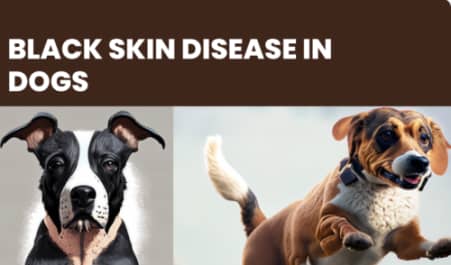Introduction:
Black Skin Disease in dogs:-
Pomeranian, Alaskan Malamute, Samoyed, Chow Chow, Siberian Husky, Miniature Poodle, Keeshond, Norwegian Elkhound, Afghan Hound, and Shetland Sheepdog (Sheltie) breeds are most commonly affected by black skin disease. Dogs of any breed and age can have black skin disease. Males are more likely than females to have the illness.
Other names for black skin illness include wooly coat syndrome, castration-responsive dermatosis, alopecia X, canine alopecia, and adrenal hyperplasia-like condition. the signs of black skin disease, which nobody can identify at first, but after two or three years, your dog’s skin begins to exhibit symptoms, so you can identify this illness.
The symptoms begin with decreasing hair on the back legs and beneath the tail; some dogs also have itchy skin; hair loss also occurs on the stomach; unfortunately, the skin eventually becomes bald; also, there is an increased risk of sunburn or frostnip and other infections
An illustration of a dog with black skin disease for better understanding:-


Symptoms of black skin disease in dogs:-
Black skin disease is a condition that affects your dog’s skin gradually, therefore you should consult your veterinarian if you notice hair loss on your dog’s body.
Symptoms:-
progressive hair loss with bald areas
Symmetrical Pattern
Skin darkening
altered thirst and appetite
behavioral changes
secondary infection of the skin
Causes of Black Skin Disease in dogs:-
The reason for black skin disease in dogs is uncertain. It’s a hormone imbalance and a hereditary condition. The signs of black skin disease appear after puberty and are frequent in male dogs.
Dogs diagnosed with black skin disease should not be preferred for breeding since the children may develop the same condition as the father.
There is currently no reliable test for canine black skin disease. There are other alternative methods for identifying black skin disease, but you must speak with your veterinarian first.
A veterinarian will do a physical examination, blood tests, stool analysis, and other diagnostic procedures to detect and treat thyroid illness, endogenous Cushing’s disease, and other parasite infections under intensive care. They are capable of doing cytology. Under a microscope, gather some skin cells and examine them for the presence of external parasites like yeast. Hormonal tests and, in certain situations, skin biopsies are required.
treatment of black skin disease in dogs:-
Treatments vary depending on the dog. The purpose of the therapy is to help your dog’s coat grow back while preventing further hair loss and attempting to grow new hair.
Since black skin disease is hereditary, it is not necessary to have more offspring from a dog that has the condition. Instead, the initial step in treating black skin disease patients should be “neutering,” or the removal of testicles, and “spying,” or the removal of testicles. Sterilizing everything that comes into contact with a dog’s skin is necessary to encourage the growth of new coat growth.
nutritional supplements:
Certain vitamins, minerals, and essential fatty acids that are vital for skin health may be found in supplements made specifically for the skin and coat. These supplements can also stimulate the growth of new hair.
Topical treatments:
Medicated shampoos, sprays, and ointments can aid in hair regrowth, infection relief, and skin healing.
environmental management:
Environmental variables, including allergens and irritants, can have a detrimental impact on a dog’s skin in black skin disease. Identify and decrease harmful factors, such as foods, chemicals, and parasites.
Hormonal therapy
Black skin disease can be caused by a hormonal imbalance, such as testosterone levels. hormonal therapy, such as treatment with a medicine that suppresses hormone synthesis or alters hormone levels in this treatment, melatonin, or include some types of medications.
and you veterinarians may select another course of therapy.
Similar to the previous piece, we also have another one about eye problems in dogs that is helpful to pet owners.
Note: The advice on this page is meant for informative purposes only and does not represent medical advice for dogs. Please schedule an appointment with your veterinarian to ensure that your pet’s ailment is accurately diagnosed.

Its such as you learn my thoughts! You seem to understand a lot about this, like you wrote
the e book in it or something. I think that you could do with some % to drive
the message home a little bit, but other than that, that is great blog.
A great read. I’ll definitely be back.